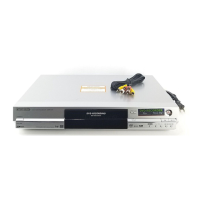1. Plug the AC cord directly into the AC outlet. Do not use an
isolation transformer for this check.
2. Connect a 1.5k , 10 watts resistor, in parallel with a 0.15 F
capacitors, between each exposed metallic part on the set and a
good earth ground such as a water pipe, as shown in Figure 1 .
3. Use an AC voltmeter, with 1000 ohms/volt or more sensitivity, to
measure the potential across the resistor.
4. Check each exposed metallic part, and measure the voltage at
each point.
5. Reverse the AC plug in the AC outlet and repeat each of the above
measurements.
6. The potential at any point should not exceed 0.75 volts RMS. A
leakage current tester (Simpson Model 229 or equivalent) may be
used to make the hot checks, leakage current must not exceed 1/2
milliampere. In case a measurement isoutside of the limits
specified, there is a possibility of a shock hazard, and the
equipment should be repaired and rechecked before it is returned
to the customer.
1.2. Caution for fuse replacement
2. Prevention of Electrostatic Discharge (ESD) to
Electrostatic Sensitive (ES) Devices
Some semiconductor (solid state) devices can be damaged easily by static electricity. Such
components commonly are called Electrostatic Sensitive (ES) Devices. Examples of typical ES
devices are integrated circuits and some field-effect transistor-sandsemiconductor "chip"
components. The following techniques should be used to help reduce the incidence of
component damage caused by electrostatic discharge (ESD).
1. Immediately before handling any semiconductor component or
semiconductor-equipped assembly, drain off any ESD on your
body by touching a known earth ground. Alternatively, obtain and
wear a commercially available discharging ESD wrist strap,
3

